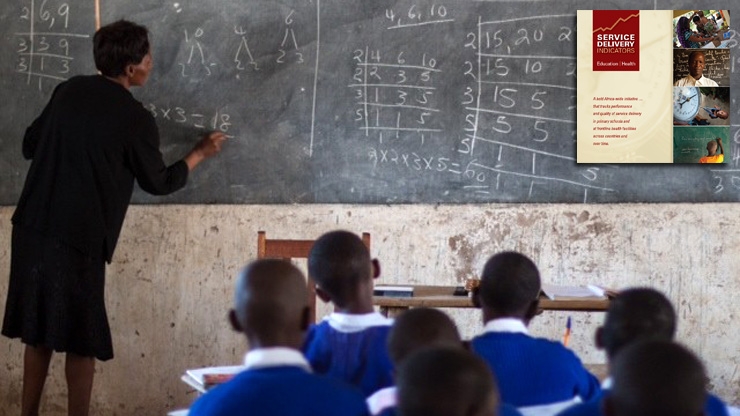NAIROBI, July 12, 2013—Thousands more babies in Kenya are surviving past infancy and 10 million children are of primary school age. These are the new faces of the country, a burgeoning population of young Kenyans that could greatly drive and expand the country’s prosperity.
As new Service Delivery Indicators (SDI) for Kenya show, urgent improvements are needed in the quality of education and health care in the country for this generation to mature into highly productive citizens, able to take advantage of economic opportunities and seek better jobs.
For example, according to SDI survey findings, children in public primary schools in Kenya are taught for only 2 hours 40 minutes a day, not even half the official teaching day of 5 hours 40 minutes. And in public health facilities, only 58% of providers could diagnose 4 out of 5 basic conditions such as malaria with anemia or acute diarrhea with severe dehydration.
Getting children to school and patients to clinics is not enough
“Although getting children into school and building and equipping clinics is a big step, it is not enough,” says Gayle Martin, who leads the Service Delivery Indicators program across Sub-Saharan Africa. “What ultimately matters for people and for the country is how well students are learning and whether patients are getting the right treatment when they visit clinics.”
Other surveys show that children do not learn to read or do basic math at the right age in primary school. And Kenya still has unacceptably high death rates among women due to childbirth-related complications. New SDI data have highlighted the main service delivery weaknesses in schools and clinics, partially explaining some of these suboptimal results.
Kenya needs to focus on ‘software’ more than ‘hardware’
The SDI findings for Kenya show that the country is doing better on the availability of key “hardware” like textbooks, equipment, and infrastructure than it is on the “software”, that is, the level of effort and knowledge seen and assessed among teachers and health providers.
Nearly all health facilities have sanitation, 80 percent of schools have enough light to read by, and textbooks per pupils exceeds Kenya’s target of three per pupil. On the medicines front, drugs for mothers remain a problem with only 58% of these drugs available in public facilities.
The modest level of effort by teachers and health providers seen in the SDI reflects room for improvement in the management of human resources. For example, over 29 percent of public health providers were absent from work, but a full 80 percent of this was sanctioned absence.
Also, while teachers at public and private schools were about as likely to show up for work, public school teachers were 50 percent less likely to be in class teaching. Children in public schools receive an average of 20 days less teaching a term than those in private schools.
Kenya could also do much better on the knowledge front. Public providers followed less than half (44 percent) of the correct treatment actions to manage maternal and neonatal complications. Among public teachers, only 35 percent showed mastery of the subjects they taught. Seniority and years of training did not correlate with higher levels of knowledge.
What this means for Kenya’s Vision 2030 goals
Kenya’s Vision 2030, which is a blueprint for economic and human development, makes particular reference to good education and to healthcare for all. The quality of education and health services will in fact determine whether the promise of Vision 2030 will be shared by everybody, especially those who live under the poverty line today.
“Education and health services are always hot button issues, with a wide range of views and opinions in any country,” Martin says. “But I think everyone agrees that public money must deliver good results. And that is what these indicators are for, to help inform the public debate within Kenya and contribute towards better results for everyone.”
Mwangi Kimenyi, Senior Fellow at the Brookings Institute and Director of the Africa Growth Initiative is upbeat about improved prospects for Kenya in the decade ahead in an age of greater transparency and open data.
"Education and Health Service delivery indicators reveal that citizens are not getting value for money," Kimenyi says. "This is powerful information that civil society and taxpayers can use to demand action on the part of the service providers and officials of the line ministries. Armed with such information, citizens are better able to hold gouvernment and providers to account."
The SDI vision: Africa-wide data for results and accountability
The main objective of the new SDI initiative, which is an Africa-wide program, is to generate robust data on the quality service delivery that can then help citizens to hold their government and service providers accountable, and push for change that delivers better results for them.
“Increasing accountability for education and health services is at the heart of the Service Delivery Indicators,” says Ritva Reinikka, Director of Human Development for Africa at the World Bank. “These new data will help governments and service providers take specific actions to deliver better services and to track the impact of reforms across time as the surveys are repeated.”
SDI can also help governments achieve greater efficiency of public spending. “Unless you know where exactly the problem is, you can’t fix it,” Reinikka notes. “Governments today are often operating within tight budgets that already devote a large share of resources to health and education—so honing in on the issues and spending money more smartly is really critical.”
A partnership of the World Bank, the African Economic Research Consortium, and the African Development Bank, the SDI initiative is funded by The William and Flora Hewlett Foundation and the World Bank. In addition, in Kenya, the surveys were supported by the Canadian International Development Agency (CIDA) and the USAID-funded Health Policy Project.
SDI data are now available for Kenya, Tanzania and Senegal, and will soon be available for Mozambique, Nigeria, Togo and Uganda. More countries will follow in 2014.


